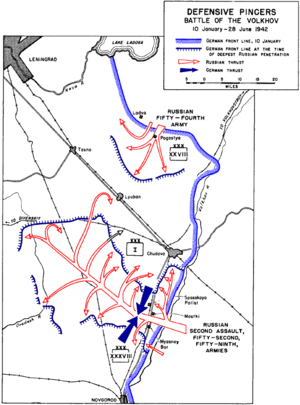Battle of Lyuban
The Battle of Lyuban, Lyuban Offensive Operation or Battle of the Volkhov (7 January 1942 – 30 April 1942) (Russian: Любанская наступательная орерация; German: Schlacht am Wolchow) was a Soviet offensive operation. It was conducted by the Volkhov and Leningrad Fronts of the Red Army with the goal of relieving the siege of Leningrad and encircling and destroying the German forces carrying out the siege.[4]
| Battle of Lyuban | |||||||
|---|---|---|---|---|---|---|---|
| Part of the Eastern Front of World War II | |||||||
 Battle of the Volkhov, 10 January – 28 June 1942 | |||||||
| |||||||
| Belligerents | |||||||
|
|
| ||||||
| Commanders and leaders | |||||||
| Georg von Küchler |
Kirill Meretskov Mikhail Khozin | ||||||
| Units involved | |||||||
| Strength | |||||||
| Approximately 200,000 men |
7 January: Volkhov Front: 327,700 men[1][2] | ||||||
| Casualties and losses | |||||||
|
56,768 men[3]
|
Volkhov Front:
| ||||||
The offensive used no tanks because of the terrain, therefore it was down to the infantry and the artillery. The attacking Soviet forces found themselves under intense fire from German defensive positions, and the Red Army lacked proper artillery support against the German lines. The offensive stalled and the Soviets went over to the defensive. Field Marshal Georg von Küchler counterattacked with an operation called 'Wild Beast" (Operation Raubtier) and the Soviet 2nd Shock Army was cut off and surrounded. It was destroyed in June 1942 and its commander Andrey Vlasov was taken prisoner.[5]
Aftermath
Analysis
The Volkhov and Leningrad Fronts lacked the armored vehicles, artillery ammunition, manpower reserves, fuel and food to mount sustained offensive operations against the German 18th Army.[6][7][8] Inadequate Soviet firepower could not reduce the German system of fortified strongpoints in the forests.[9] The Germans inflicted heavy losses on the attacking Soviet forces and forced the exhausted Red Army to the defensive.[9] According to general Mikhail Khozin, Soviet armored forces and artillery firepower did not exist in sufficient quantities to exploit penetrations and defeat German counterattacks.[8]
Citations
- Glantz 2000, p. 184.
- Krivosheev 1997, p. 108.
- "Archived copy". Archived from the original on 31 May 2013. Retrieved 26 December 2017.CS1 maint: archived copy as title (link)
- Glantz 2000, p. 130.
- Glantz 2000, p. 129.
- Forczyk 2009, p. 36.
- Glantz 2000, p. 154.
- Glantz 2000, p. 186.
- Glantz 2000, p. 161.
Bibliography
- Forczyk, Robert (2009). Leningrad 1941–44: the epic siege. Oxford: Osprey. ISBN 978-1-84603-441-1.CS1 maint: ref=harv (link)
- Glantz, David M. (2000). "Forgotten Battles of the German-Soviet War (1941-45), Part 5: The Winter Campaign (5 December 1941‐April 1942): The Leningrad Counteroffensive". Journal of Slavic Military Studies. 13 (4): 127–192.CS1 maint: ref=harv (link)
- Krivosheev, Grigoriy (1997). Soviet Casualties and Combat Losses in the Twentieth Century. London: Greenhill Books. ISBN 1-85367-280-7.CS1 maint: ref=harv (link)